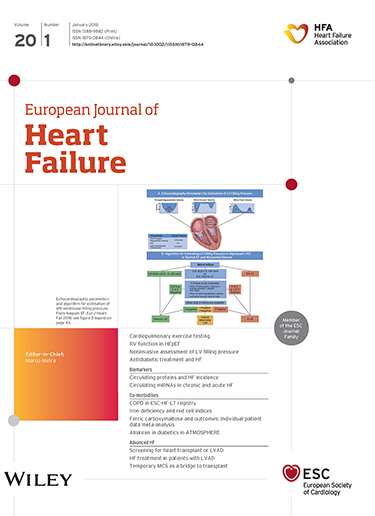远程肺动脉压力引导心力衰竭患者的管理:ESC心力衰竭协会(HFA)的临床共识声明
IF 16.9
1区 医学
Q1 CARDIAC & CARDIOVASCULAR SYSTEMS
引用次数: 0
摘要
心衰恶化是计划外住院的主要原因。其发病前通常是早期心内压升高,随后因充血而加重症状。植入式装置允许每日远程监测肺动脉压(PAP),有助于识别早期血流动力学变化,以便在症状出现之前的早期阶段调整药物治疗,并预防HF相关住院。其次,使用这些设备可能有助于维持临床稳定性,使PAP每天保持在目标范围内。CardioMEMS系统允许远程PAP监测,并且PAP引导的药物治疗在前瞻性、随机、对照临床试验中减少了与心衰相关的住院治疗,独立于他们的左心室射血分数。其他设备的安全性和可行性,如Cordella植入式PAP传感器,也已得到证实,目前正在几项试验中评估在更大患者群体中的临床有效性。大多数测试远程PAP监测的研究都是在2021年欧洲心脏病学会心衰指南之后报道的。因此,更新这些系统的临床意义和临床实践的潜在影响似乎是必要的。本临床共识声明的目的是总结目前对心衰患者远程PAP引导管理的知识,特别关注临床试验的当前证据,对临床实践和管理方面的潜在影响。本文章由计算机程序翻译,如有差异,请以英文原文为准。
Remote pulmonary artery pressure‐guided management of patients with heart failure: A clinical consensus statement of the Heart Failure Association (HFA) of the ESC
Episodes of worsening heart failure (HF) are a major cause of unplanned hospitalizations. Their onset is usually preceded by an early increase in intracardiac pressures with subsequent worsening of symptoms due to congestion. Implantable devices allowing daily remote pulmonary artery pressure (PAP) monitoring are useful to identify early haemodynamic changes so that medical therapy can be adjusted at an early stage, before symptom onset, and HF‐related hospitalizations be prevented. Second, the use of these devices may help to maintain clinical stability keeping PAP in the target range on a day‐to‐day basis. The CardioMEMS system allows remote PAP monitoring, and PAP‐guided medical therapy has reduced HF‐related hospitalizations in prospective, randomized, controlled clinical trials in symptomatic patients with HF, independent of their left ventricular ejection fraction. The safety and feasibility of other devices, like the Cordella implantable PAP sensor, have also been demonstrated and clinical usefulness in larger patient populations is currently being assessed in several trials. Most of the studies testing remote PAP monitoring were reported after the 2021 European Society of Cardiology HF guidelines. An update of the clinical significance and potential implications for clinical practice of these systems seems therefore warranted. The aim of this clinical consensus statement is to summarize current knowledge on remote PAP‐guided management of patients with HF, with a special focus on current evidence from clinical trials, potential impact on clinical practice and management aspects.
求助全文
通过发布文献求助,成功后即可免费获取论文全文。
去求助
来源期刊

European Journal of Heart Failure
医学-心血管系统
CiteScore
27.30
自引率
11.50%
发文量
365
审稿时长
1 months
期刊介绍:
European Journal of Heart Failure is an international journal dedicated to advancing knowledge in the field of heart failure management. The journal publishes reviews and editorials aimed at improving understanding, prevention, investigation, and treatment of heart failure. It covers various disciplines such as molecular and cellular biology, pathology, physiology, electrophysiology, pharmacology, clinical sciences, social sciences, and population sciences. The journal welcomes submissions of manuscripts on basic, clinical, and population sciences, as well as original contributions on nursing, care of the elderly, primary care, health economics, and other related specialist fields. It is published monthly and has a readership that includes cardiologists, emergency room physicians, intensivists, internists, general physicians, cardiac nurses, diabetologists, epidemiologists, basic scientists focusing on cardiovascular research, and those working in rehabilitation. The journal is abstracted and indexed in various databases such as Academic Search, Embase, MEDLINE/PubMed, and Science Citation Index.
 求助内容:
求助内容: 应助结果提醒方式:
应助结果提醒方式:


